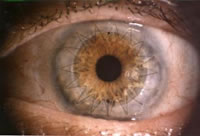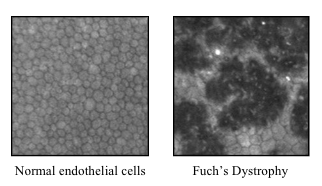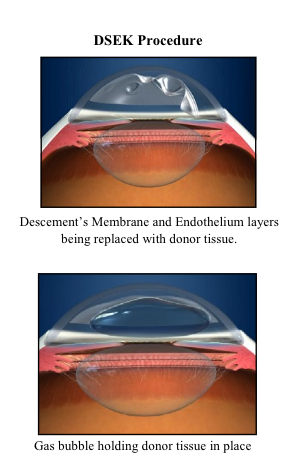 A corneal transplant, also known as penetrating keratoplasty, is a surgical procedure in which the surgeon removes the central portion of the cornea (called a button) and replaces it with a donor cornea. Corneal transplants are performed on patients with damaged or scarred corneas. The damage may have been caused by disease or trauma. Corneal transplants are extremely delicate procedures, but they have a high rate of success.
A corneal transplant, also known as penetrating keratoplasty, is a surgical procedure in which the surgeon removes the central portion of the cornea (called a button) and replaces it with a donor cornea. Corneal transplants are performed on patients with damaged or scarred corneas. The damage may have been caused by disease or trauma. Corneal transplants are extremely delicate procedures, but they have a high rate of success.
Fuch’s Dystrophy
Fuch’s dystrophy is a slowly progressing, inherited disease that usually affects both eyes and is slightly more common in women than in men. Although doctors can often see early signs of Fuch’s dystrophy in people in their 30’s and 40’s, the disease rarely affects vision until a person reaches their 50’s and 60’s.
Fuch’s dystrophy occurs when endothelial cells gradually deteriorate without any apparent reason. Once lost, these cells do not grow back. As more endothelial cells are lost over the years, the cornea, the clear front window of the eye, becomes less efficient at pumping water out. This causes the cornea to swell and to distort vision. Eventually, the epithelium also takes on water, resulting in blurry vision and discomfort as the cornea swells.
Symptoms
Corneal swelling damages vision in two ways:
- Changing the cornea’s normal curvature
- Causing a sight-impairing haze to appear in the tissue.
In the early stages of Fuch’s dystrophy, a person will awaken with blurred vision that will gradually clear during the day. This occurs because the cornea is normally thicker in the morning, and it retains fluids during sleep that evaporate while we are awake.
Treatment
Medical
When treating the disease, doctors will try first to reduce the swelling with eye drops, ointments or soft contact lenses. They may also instruct a person to use a hairdryer,
held at arm’s length or directed across the face, to dry out the epi-helial blisters. This can be done two or three times per day.
Surgical
Descemet’s Stripping Endothelial Keratoplasty, also know as DSEK, is a procedure that can be done to treat Fuch’s Dystrophy. With this procedure, a thin layer of the cornea (descemet layer and endothelial cells) is removed from a donor and inserted into the eye through a small incision. An air bubble is injected to properly position the cornea in place. This procedure is performed with a topical anesthetic to minimize any potential discomfort. DSEK is known to have quicker recovery time and your vision will improve. DSEK can be repeated due to occasional rejection.





